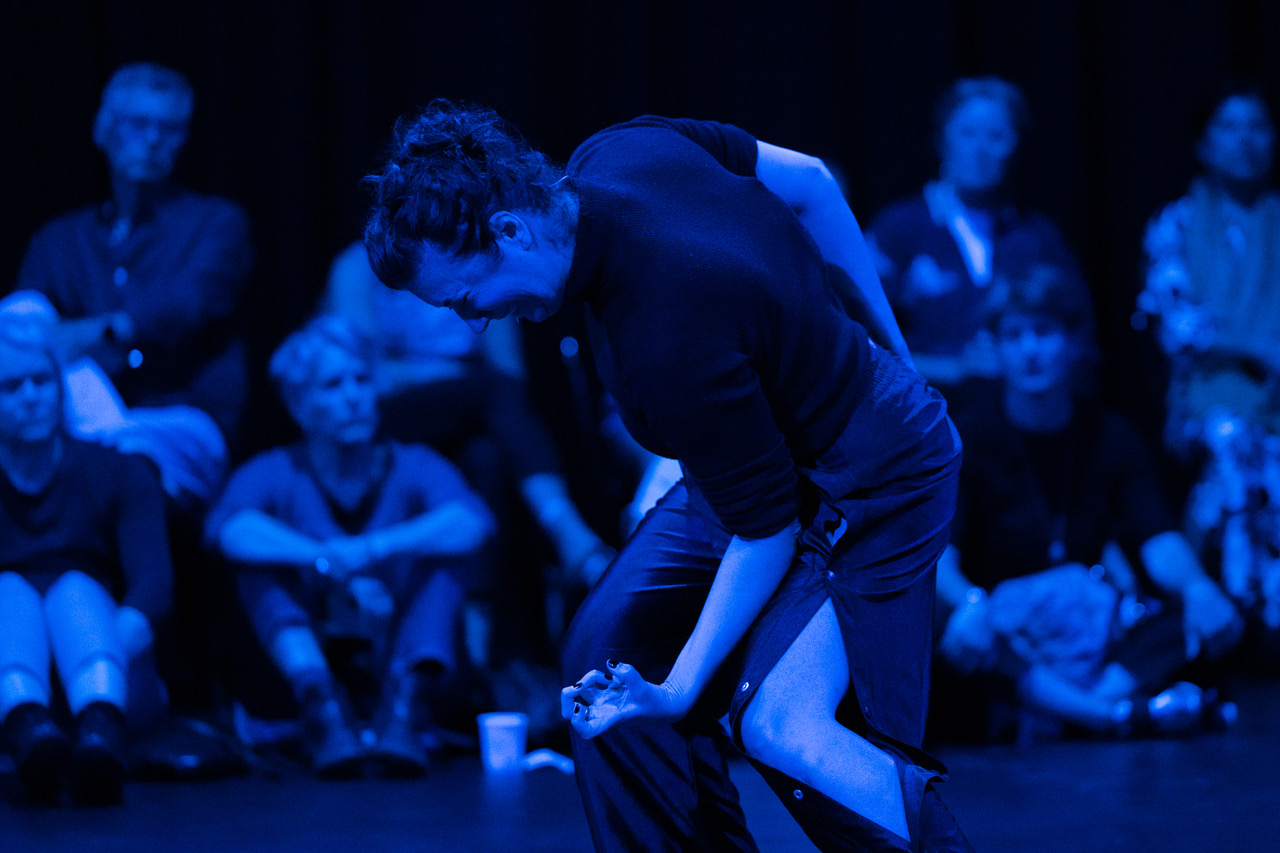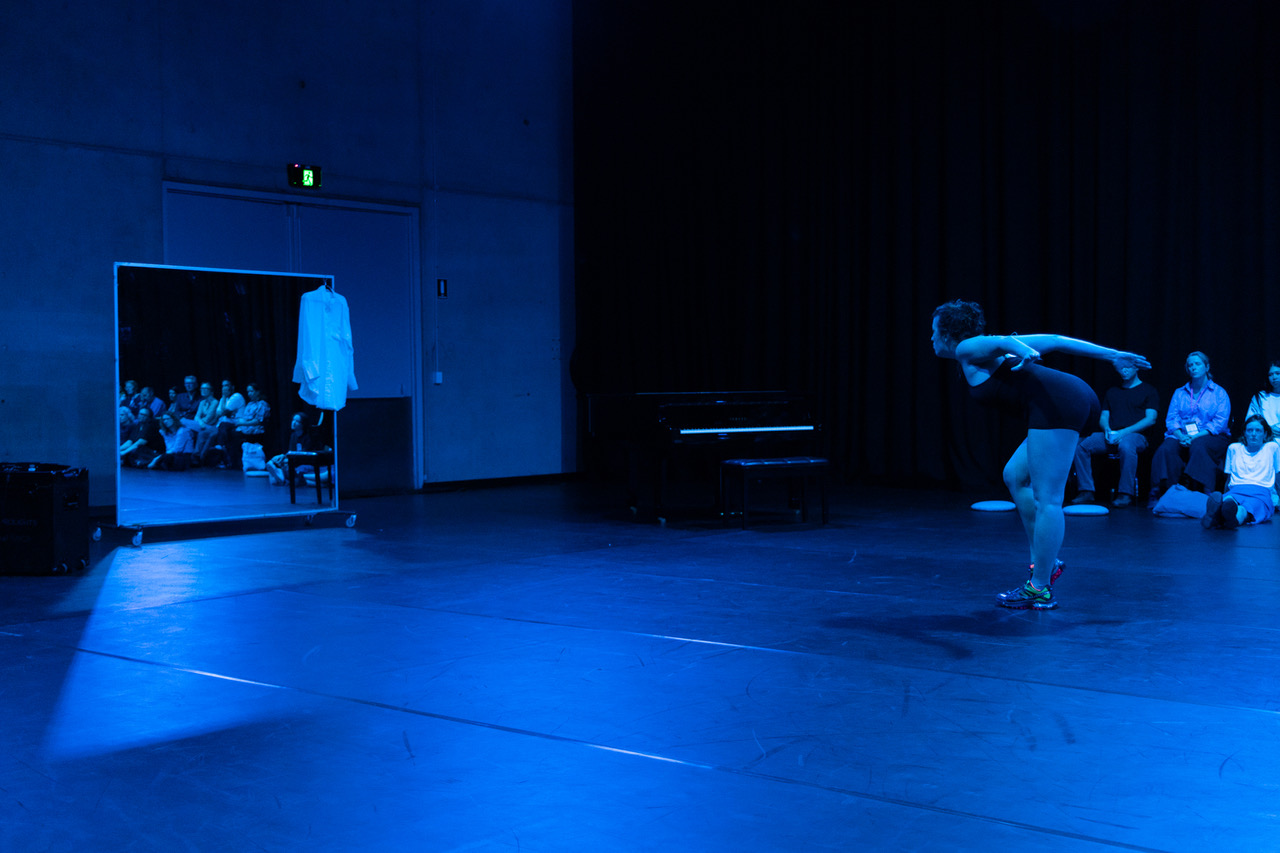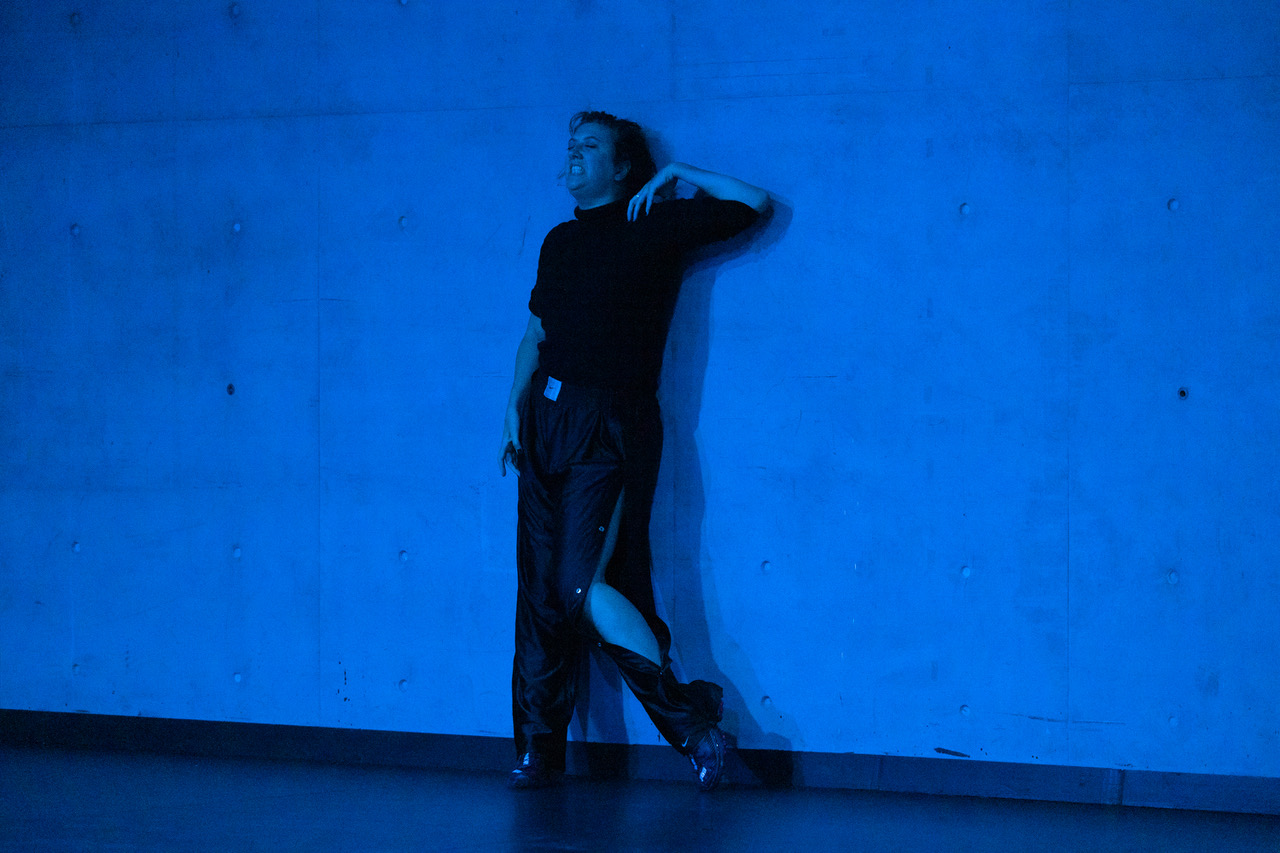
Liveworks 2023: Brooke Stamp, Mickey, Amplifying dance’s psyche
Perhaps it was the rejection of the proposed Voice for Australia’s First Nations peoples; the public refusal, or inability, to understand or acknowledge difference. Perhaps it was the massacre in Israel and the terror now wrought on the people of Gaza. Perhaps it was one war eclipsing the other in Ukraine. Perhaps it was all of this overshadowing the now apocalyptic tenor of climate change. Perhaps then my response to Brooke Stamp’s Mickey, as performed on 24 October, the opening night of Performance Space’s 2023 Liveworks, as a work of grieving.
Articulating the psychophysical
Mickey is an ideal work to kick off a festival of experimental arts: a performance experienced as emotionally and physically powerful, seductively elusive and richly allusive and wrought like a disturbing dream. Each performance is claimed to be quite different. “Informed by absorbed choreographic practice and dance history, Stamp’s body memory is presented as an improvised subconscious psychic waste, the content of the improvisation an articulation of what the artist terms ‘psychophysical’“ (Program guide).
In a Liveworks interview about the residency from which Mickey (originally conceptualised as “the line is a labyrinth”) sprang, Stamp says, “I wanted to explore dance’s subterranean impetuses, and to develop an audial practice that uses live processing to augment spoken language and other psychic and subconscious slippages that keep company with my practice — in an effort to dislocate dance from its obligation to bodily form.”
Stamp’s project aspires to fuse psychoanalysis with metaphysical transcendence: “Dance naturally signifies ‘bodies’ as the primary subject of dance but I’m curious to reconceptualize the centrality of the body via the expression of bodily subconsciousness. I want to tap the idea of a universal bodily matrix significantly more elastic, malleable and versatile.” She describes a “practice that interrogates and reorganizes inherited thought and movement systems – to rather reposition the whole-body sensorium as one that favours the psychic crevices, the symbols, spirits, sensations, spasms, and slippages – that better reflect my body’s potential as an agent across time.”
This “improvised subconscious psychic waste” makes for a fascinating performance providing moments of intriguing specificity, motifs and clues. Why “Mickey,” rather than the abstract “the line is a labyrinth”? Perhaps there is a real Mickey, or a floating signifier ‘Mickey’ with multiple subconscious associations; we’re not to know, but we might guess, or sense.
As a “dislocat(ion) of dance from its obligation to bodily form,” Mickey is fascinating, viscerally performative, formally unpredictable, danced and not danced, complexly voiced and the body sounded. Stamp is one of a long line of rule breakers who have sought to free dance from strictly embedded choreographic codes and conventional theatricality from, among other trajectories, Duncan to Graham, Cunningham to Judson Church, to 1990s conceptual dance and on, to a point where a weave of dance forms and other performative practices can inhabit the dancing body without overpowering or rendering it inauthentic (see part 6 of Amanda Card’s Body for Hire, the State of Dance in Australia, Platform Paper 8, Currency House, April 2006). Stamp wants this ongoing process of liberation to go further and deeper utilising whatever improvisation brings to the surface that is performance.
The dream
With her audience intimately placed on either side of a long performance space, piano, sound and lighting desks at one end, a large rectangular mirror on wheels at the other, Brooke Stamp occupies her territory (design Sidney McMahon), lit in an enveloping intense blue, with everyday ease. There are wandering walks, muscle flexing and prop distribution between episodes in which Stamp unleashes sound and movement, much of it executed with a durational intensity of effort and inflected from time to time with expertly articulated grace notes from modern and classical dance languages. Sounds pour from Stamp’s head-miked body, words we grasp at in the dense surround sound mix that sound designer-composer Daniel Jenatsch builds from the performer’s breath, vocalisations, the churn of spittle, whistling and dry retching. Each sono-physical episode is both a substantial exploration of ways of performing and suggestive of the “psycho-physical.” The eeriness of the pervasive blue light adds to the sense of dreaming.
There are sounds other than Stamp’s. Leading into the performance there’s an electronic trickle, a little like muted rainfall; later there’s heavy rumbling, not quite thunder; lyrical electric guitar and, quite chilling, the squeal of car tyres going into a slide, but minus the expected crash. The meaning of these motifs, independent of Stamp’s body, is not immediately evident, but they introduce a soundtrack-like element of dramatic effect punctuating Stamp’s performance. These together with the sheer physical and vocal intensity of Stamp’s performance suggest emotional disturbance, especially when correlated with the words she speaks, repeated fragments, never a coherent expression of a state of being. Perhaps, I began to feel, this was a body possessed by grief. (I was later told that in another performance in the season this was not evident.)
I didn’t go looking for a theme, but I did want to know why the title, Mickey? Why at the first mention of Mickey, a high, raw chord seemingly identified with the sun, as Stamp’s body moves with a stressed fluidity. “Fuck, I’m stuck under the sun,” she utters; then, “We all make mistakes,” her body flat to the floor. She can hear something “softly in my ear,” makes small cries underlined by crashing static. “It’s Michael … good job, Michael,” she utters as the guitar soars sweetly over the accumulating reservoir of sound. The car tyres squeal. Silence. Stamp’s arms and legs fan out at 45 degrees each, fully extended into a response to some inner force, or pain.
She wheels the mirror to the other end of the space and poses variously before it at length, close-up and distant; a passage of self-estimation? The sounds heard are “M …M… Ma…ma” or is it “Mi… Mi…”? I’m not sure, but it’s not Mickey, or Michael. A struggle to utter the name? Next, Stamp buzzes like an insect until the whole space is furiously abuzz. The car tyres squeal, there is no reprieve.
After a moment of “I can’t …” weakness, Stamp assumes a “wolf”-like strength and dances formally and elegantly. But Mickey is again invoked. Standing half behind a curtain as if looking through a doorway, Stamp asks, “Mickey, did you steal my blouse …. my magic gloves?”
In a sequence of rare calm, Stamp whistles with eloquent ease, extends her left arm and cups an imaginary bird with which she duets, their beautiful call and response multiplying across the room. Car tyres squeal and she must let the bird go, opening one of the large studio doors to reveal an ominously deep orange light into which the bird is freed.
Furiously discarding clothing (there are multiple outfit changes), Stamp wonders why she feels “so hot,” “on edge,” though assuring herself “It’s working out pretty well for me.” But no, she goes to a wall at the end of the traverse and commences an exacting series of piercing dry-retchings, arms and legs splayed flat in violent danced formations against the surface. Then she’s “fine,” if that’s what I heard.
She walks to a small lighting desk and deletes the enveloping blue. Halfway down the space she sits, holding a bunch of roses, right next to me, and sings exquisitely what sounds like a fragment from a Baroque aria; I catch at words: “let me sigh …breathe … be free.” A desire for release from a state of torment, perhaps grief, or perhaps the sweet relief of having passed through it?
The dreamwork
Experiencing Mickey was like dreaming, me doing my own dreamwork with it, sensing, even imposing a shape that Stamp’s “psychic waste” might in fact resist. I had no desire to literalise the performance. For most of it I was taken by the richness of the experimental interplay between voice, body and sound design/composition and Stamp’s ability to convey intense, if often indeterminate, states of being. Her movement, even at its most extreme or held in taut near stillness, is executed with a dancer’s skill and adroitly interwoven with the surfacing of recollected dance. At the same time, each fragmented utterance, sound world or repeated gesture cumulatively built my own imaginings.
Stamp’s dance body memory might include performing in the 2009 revival of Philip Adams’ Ampflication (1999) for his company BalletLab: “set in those attenuated moments between a car crash and death, the performers flung and were flung in hyperreal fashion,” RealTime 33, p2, 1999. Or, in Adams’ Aviary (RealTime 106, 2011), its dancers performing as birds, or her own And All Things Return To Nature (RealTime 116, 2013) for BalletLab in which, as in Mickey, the performers’ chants were picked up and layered “forming a cascading aural blanket of indiscernibility.”
There is no knowing what memories will surface via Stamp’s improvisational strategy, for either artist or audience. However, Mickey is not a loose improvisation from Stamp and dramaturg Brian Fuata; it is structured, its episodes cleanly delineated, and closes with a sense of purpose. A bottle of champagne, a prop Stamp moved about, was left unopened in the performance I saw. Some of us pondered the significance. Perhaps there was not enough reason for celebration this time, or would it always be put off, such can be the nature of grieving. Or the improviser’s subconscious just didn’t call for champagne.
I would have drunk a toast in honour of Mickey, celebrating its dream-like intensity and odd logic, while erasing recollection of irritation felt when an episode over-extended or seemed to duplicate its exploration of a state of being. I’d love to see Mickey again, though knowing it would likely never be the same. Here’s to you Mickey, Michael, M…; but, “Mickey, did you steal my blouse …. my magic gloves?”
A blue note
Another query was about the darkly radiant blue light that dominated audience and performer for almost all of the performance. For many people blue conveys a sense of calm and introspection. For others it can be cold, depressive and impersonal. In the dream-like state of engaging with Mickey, I oscillated between repose as I sank into the reverie of engagement, or discomfort when the performance became harrowingly insistent, the blue then oppressive. Incidentally, the installation of blue lights in Japanese railway stations early in the last decade allegedly reduced suicide attempts by more than 80%.
……………..
Brooke Stamp was the 2022 recipient of Performance Space’s Experimental Choreographic Residency in partnership with Critical Path. Mickey is commissioned by Performance Space, Sydney and HOTA (House of the Arts), Gold Coast.
Performance Space, Liveworks 2023, Mickey, lead artist, performer Brooke Stamp https://brookestamp.com/, music Daniel Jenatsch, design Sidney McMahon, dramaturg Brian Fuata, research consultant Matthew Day; co-commissioned with HOTA, Gold Coast; Carriageworks, Sydney, 19-22 October
–
Top image credit: Brooke Stamp, Mickey, Liveworks 2023, photo Matthew Miceli








